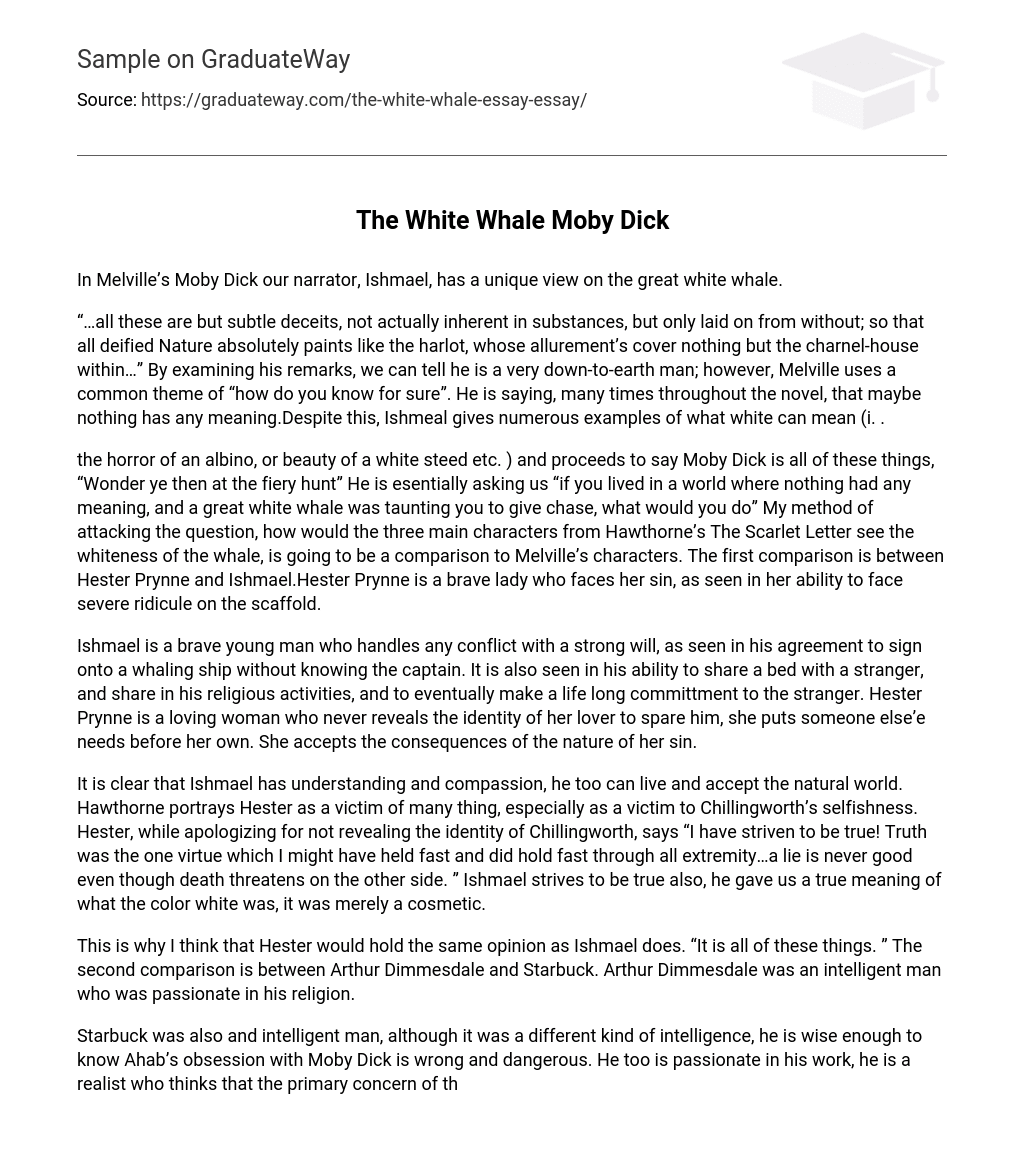In Melville’s Moby Dick, Ishmael, the narrator, has a distinctive perspective on the magnificent white whale.
Despite the use of subtle deceits and external impositions, the essence of substances remains unaffected. Just like a harlot whose allure hides a charnel-house, deified Nature also conceals its truth. Melville employs this theme of uncertainty throughout his remarks, portraying himself as a grounded individual. Through the novel, he questions the certainty of meaning, suggesting that nothing may truly hold significance. Ishmael, notwithstanding this skepticism, provides various instances to illustrate the possible interpretations of the color white (i.e. white can mean…).
The author discusses the concept of the white whale in relation to symbols of horror and beauty such as an albino and a white steed. They suggest that Moby Dick encompasses all of these qualities and wonders if we would be amazed by the hunt for such a creature. They propose comparing the perspectives of the three main characters from Hawthorne’s The Scarlet Letter to Melville’s characters in order to understand how they would perceive the whiteness of the whale. The first comparison is between Hester Prynne and Ishmael. Hester Prynne demonstrates bravery by confronting her sin, as evidenced by her ability to endure intense criticism on the scaffold.
Ishmael is a brave individual who fearlessly confronts challenges, as seen in his decision to join a whaling vessel despite not being acquainted with the captain. Moreover, he displays courage by willingly engaging in religious practices and sharing a bed with an unfamiliar person, which ultimately results in a lifelong commitment. In contrast, Hester Prynne exemplifies compassion as she opts to shield her lover’s identity and places another person’s well-being before her own. She embraces the repercussions of her wrongdoing and handles them gracefully.
Both Ishmael and Hester demonstrate understanding and compassion, allowing them to appreciate and accept the natural world. In Hawthorne’s portrayal, Hester becomes a victim of various circumstances, particularly falling prey to Chillingworth’s self-centeredness. Despite feeling remorse for not revealing Chillingworth’s identity, Hester emphasizes her dedication to truth, proclaiming that “I have striven to be true! Truth was the one virtue which I might have held fast and did hold fast through all extremity…a lie is never good even though death threatens on the other side.” Similarly, Ishmael also seeks truth by providing us with the true significance of the color white, which he perceives solely as a cosmetic.
This is why I believe Hester would share the same viewpoint as Ishmael does – “It is all of these things.” Another comparison can be drawn between Arthur Dimmesdale and Starbuck. Arthur Dimmesdale was an intelligent individual who possessed fervor for his faith.
Starbuck possesses a different type of intelligence than Ahab, but he is wise enough to recognize the wrong and perilous nature of Ahab’s obsession with Moby Dick. Starbuck is also passionate about his work and takes a realistic approach, valuing the collection of whale oils to provide wealth for the crew. Despite their intelligence, both men have tragic flaws. Dimmesdale, on the other hand, conceals his sin and refuses to admit that he is Hester’s lover, thereby compounding its severity.
When Chillingworth attempts to pressure him, he makes an evident effort to defend his actions. He permits Chillingworth to impose guilt upon him to the extent that he borders on insanity. However, after a span of seven years, he conquers his vulnerability and discloses that he is indeed Pearl’s biological father. The tragic flaw of Starbuck lies in his susceptibility to openly critique his captain.
When Ahab declares his mission to the crew, Starbuck questions him, suggesting that seeking revenge on a mindless creature is futile. As Ahab continues to explain his motives, he can only sigh and express his desperation, pleading for divine assistance. Ahab’s struggle with his weakness does not span seven years like Dimmesdale’s, but in chapter one hundred and four, Starbuck confronts him and challenges his ignorance regarding the oil vats. A tense standoff culminates with Ahab pointing a gun at Starbuck, who warns him to be cautious of his own destructive tendencies. This similarity in perception leads me to believe that both Starbuck and Arthur Dimmesdale would overlook the whale’s symbolic significance and perceive it merely as a brute creature.
The text compares Ahab and Roger Chillingworth, highlighting their similarities. Both characters are delayed emergence characters, physically deformed, and initially presented as victims. Ahab and Chillingworth both possess a calm and intelligent demeanor, concealing their anger, at least temporarily.
Chillingworth commits two grave transgressions related to the misuse of love. Firstly, he decides to marry Hester despite being aware that he is an unsuitable husband for her. Secondly, he manipulates someone else’s emotions, demonstrating his willingness to sacrifice another individual in order to fulfill his own selfish desires.
The text clearly shows that Ahab engages in multiple wrongful actions. At first, he dishonestly reveals his true mission to the ship’s owners, which undermines trust. Additionally, his relentless pursuit of Moby Dick results in the subjugation of his entire crew. Ahab’s insatiable thirst for revenge compels him to put the lives of his own crew at risk.
Both Chiilingworth and Ahab attempt to shift blame for their self-destruction, but they should acknowledge their own responsibility. Both aspire to god-like status but ultimately become devils. Thus, they perceive the whale as solely embodying all evil in the world. “The Albino whale was all of these things, wonder ye then at the fiery hunt.” The whiteness is merely superficial, as it never possesses a definite meaning.
The significance of an object lies in the level of value ascribed to it by an individual.





